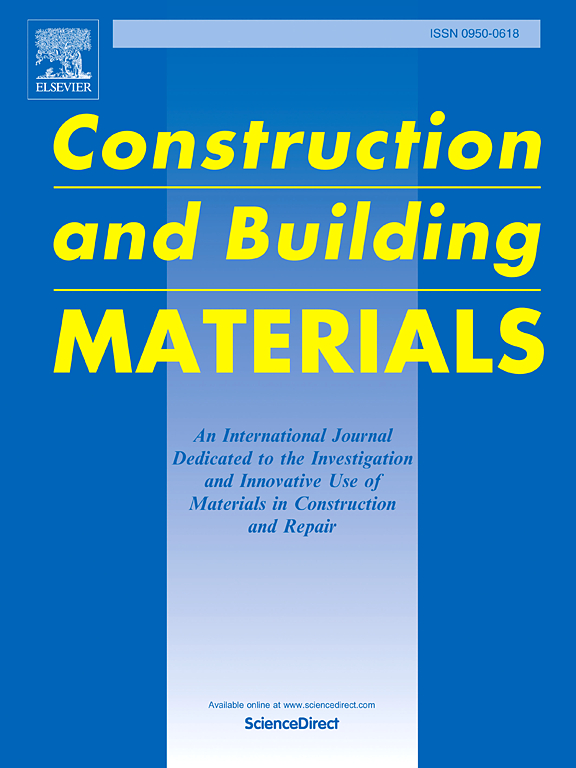Ultrafast-setting magnesium phosphate cement prepared from low-burned magnesium oxide for mixed stirring extrusion function integrated 3D printing applications
IF 7.4
1区 工程技术
Q1 CONSTRUCTION & BUILDING TECHNOLOGY
引用次数: 0
Abstract
Regarding the issues of high cost, energy consumption and low activity in the existing preparation of magnesium phosphate cement (MPC) using heavy-burned magnesium oxide as raw material, this paper aims to prepare ultrafast-setting MPC using low-burned magnesium oxide. The objective was to explore the laws and mechanisms by which different magnesium oxide calcination temperatures affect the setting time, compressive and bond strengths, volumetric stability, and microstructure of MPC, thereby determining the optimal calcination temperature of magnesium oxide. Then, taking the setting time and compressive strength as performance indices, this paper determines the optimal baseline values of each component of MPC. Specifically, it ascertains the magnesium-phosphorus ratio, water-binder ratio, and borax doping amount. Subsequently, it integrates with the Mixed Stirring Extrusion Function Integrated 3D (MSEFI-3D) printing process to realize the application of MPC. The results reveal that, in comparison with MPC prepared from traditional heavy-burned magnesium oxide, appropriately reducing the calcination temperature of magnesium oxide can effectively enhance the mechanical properties of MPC and improve its volume stability. The compressive strength and interfacial bonding strength of MPC reach their optimal values when the calcination temperature of magnesium oxide is within the range of 850–950°C. Furthermore, the MPC prepared at this calcination temperature demonstrates excellent extrudability and constructability during the printing process. It can satisfy the requirements of 3D printing, thus providing a reference for the 3D-printing application of ultrafast - setting MPC prepared from low - burned magnesium oxide.
由低烧氧化镁制备的超快凝磷酸镁水泥,用于混合搅拌挤压功能集成3D打印应用
针对现有以重烧氧化镁为原料制备磷酸镁水泥(MPC)存在成本高、能耗大、活性低等问题,本文旨在以低烧氧化镁为原料制备超快凝型磷酸镁水泥。探讨不同氧化镁煅烧温度对MPC凝固时间、抗压强度、粘结强度、体积稳定性和微观结构的影响规律和机制,从而确定氧化镁的最佳煅烧温度。然后,以凝固时间和抗压强度为性能指标,确定了MPC各组分的最优基线值。具体来说,确定了镁磷比、水胶比和硼砂掺杂量。随后,与混合搅拌挤压功能集成3D (MSEFI-3D)打印工艺相结合,实现MPC的应用。结果表明,与传统重烧氧化镁制备的MPC相比,适当降低氧化镁的煅烧温度可以有效提高MPC的力学性能,提高MPC的体积稳定性。当氧化镁煅烧温度在850 ~ 950℃范围内时,MPC的抗压强度和界面结合强度达到最佳值。此外,在此煅烧温度下制备的MPC在印刷过程中表现出优异的挤压性和可构造性。可以满足3D打印的要求,为低烧氧化镁制备的超快凝固MPC的3D打印应用提供参考。
本文章由计算机程序翻译,如有差异,请以英文原文为准。
求助全文
约1分钟内获得全文
求助全文
来源期刊

Construction and Building Materials
工程技术-材料科学:综合
CiteScore
13.80
自引率
21.60%
发文量
3632
审稿时长
82 days
期刊介绍:
Construction and Building Materials offers an international platform for sharing innovative and original research and development in the realm of construction and building materials, along with their practical applications in new projects and repair practices. The journal publishes a diverse array of pioneering research and application papers, detailing laboratory investigations and, to a limited extent, numerical analyses or reports on full-scale projects. Multi-part papers are discouraged.
Additionally, Construction and Building Materials features comprehensive case studies and insightful review articles that contribute to new insights in the field. Our focus is on papers related to construction materials, excluding those on structural engineering, geotechnics, and unbound highway layers. Covered materials and technologies encompass cement, concrete reinforcement, bricks and mortars, additives, corrosion technology, ceramics, timber, steel, polymers, glass fibers, recycled materials, bamboo, rammed earth, non-conventional building materials, bituminous materials, and applications in railway materials.
 求助内容:
求助内容: 应助结果提醒方式:
应助结果提醒方式:


